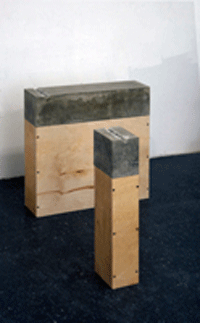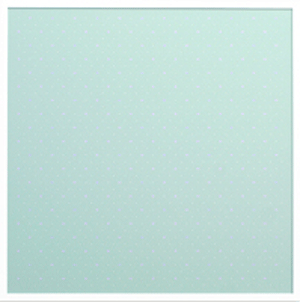-
Unspecific Specificities: Objects at Thierry Goldberg
by Joseph Akel March 30, 2010

A recent visit to Thierry Goldberg Project’s small Lower East Side gallery reminded me of Donald Judd’s continuing and pervasive influence on a current crop of contemporary Neo-Minimalists. Rivington Street, however, is far from the arid, grassy plains of the Texas panhandle and whether Judd’s legacy is being faithfully upheld by the current Goldberg exhibition, Unspecific Objects, is a matter of debate. Taking as its curatorial starting-point Judd’s seminal essay from 1965, “Specific Objects,”, the Goldberg show can be viewed as a lesson in the many ways Judd’s writings have come to be interpreted amongst a contemporary set of curators and artists.
One could argue that Unspecific Objects, like so many recent shows referencing past vanguards, is simultaneously a retrospective of one individual’s conceptual legacy and a showcase for a new generation returning to and reworking that same heritage. One of the potential problems with this approach is that, located within such a specific conceptual/historical text, the works included open themselves to a level of dogmatic scrutiny that can undermine the artist’s intention. The viewer may find themselves primarily concerned with whether the exhibition is successful as organized and inspired by the writings of Donald Judd instead of examining the value of the works themselves.
It is certainly clear that Judd and his impact on Minimalism has influenced the exhibited works The real question is, do they constitute art that exists in accordance with Judd’s notion of the “specific object” while concomitantly reinventing or repositioning that concept? Or, is the Goldberg show yet another example of the popular, vulture-ike practice of taking certain elements from well-known texts and building whole shows from them, disregarding the literary carcass from which it came?
Written in the year after his first solo show at New York’s Green Gallery, “Specific Objects” was, as Charles Harrison observes, “noteworthy for its claim that the representative art of the modern is now neither painting nor sculpture but the virtual medium of ‘three-dimensional work’.” For Judd, a leading figure “of [that] apostate Modernism” which was to become Minimalism, the rejection of traditional artistic craftsmanship and expression infused work that broke ground exploring light, space, interval, and color. Directing his attention to volume and the presence of structures and the spaces around them, Judd made the viewer aware of the greater physical and psychic relationships between subject, object, and site.
Judd first coined the term “specific objects” in reference to structures that were neither paintings nor sculptures, but rather objects that existed liminally between the two. In the 1965 essay bearing Judd’s neologism as its title, we find a desire to transform the art-object into a self-sufficient creation and also to eliminate any factor interfering with the physical qualities of the art-object’s composite materials. Judd himself would claim, “[a] shape, a volume, a surface is something in itself.” Radically rethinking the Hegelian concept of artistic origination, Judd in essence argued for a new creative paradigm in which the artistic-object was created not through the alteration and synthesis of material, but in its temporal and spatial reinterpretation.

No artist in Unspecific Objects comes closer to realizing Judd’s “object” ethos than David Scanavino whose installation is located in the gallery’s back room. With Untitled (one square inch), the Goldberg gallery floor has been covered in black and white-flecked linoleum where, seemingly from beneath the menacing P.V.C. flooring, a small cube protrudes. From a specific point of view, the cube appears to melt into the floor, deliquescing into the site of its origin. In effect, Scanavino transforms the entire room into an object of contemplation, the black linoleum a psychic counterpoint to the walls and ceiling of the white cube. Scanavino’s installation becomes a total site, interfacing itself within a greater web of meaning extending beyond the work, physically expanding both the site and concept of it towards an “indefinable sum of a group of entities and references” (as Judd defined a “three-dimensional” work).
In contrast, Daniel Ellis’ SOSO Mint Green and SOSO Black/Black, as well as Rashawn Griffin’s The Haberdasher readily fall into a trap identified in “Specific Objects.” On two 36”x36” canvasses, Ellis repetitiously places the international Morse code distress signal (• • • — — — • • •), or SOS as it’s commonly known prosign, over both mono and dichromatic backgrounds. The conformity to traditional framing conventions, but also Ellis’ use of painting within established confines, wholly “determines and limits,” as Judd wrote in “Specific Objects,” “the arrangement of whatever is on or inside of it.”

Perhaps as a reaction to Judd’s aversion towards a fixed planar form of painting, Griffin’s canvass is suspended from the gallery ceiling, the result of which makes both sides visible. One side of the 33”x46” canvass is fully covered in a gray argyle patterned fabric, with the reverse side the same but with an added small, loosely composed collage on top. The press release asserts that Griffin’s work, “free standing and sometimes suspended,” speaks to “the sculptural presence of painting.” However, let us be clear: this is not the three-dimensional work Judd was speaking of, and the facile explanation that, in suspending a canvass, such an effect is achieved, does Griffin and his work little justice.
For both Ellis and Griffin, the merits of their respective works are lost in their apparent inability to channel or re-invent the paradigms developed in “Specific Objects.” Thus, while Ellis’ work maybe a highly stimulating meditation on a system of valuation rooted in inherently meaningless and artificial symbology, when measured against the standard set by Judd for his essay, Ellis is unable to break free from the yoke of traditional European art. With Griffin, the attempt to engage in Judd’s 3-D concept of the “specific object,” fails because the image is not liberated from its rectangular frame, regardless of its suspension. As Judd noted, we all know that “anything on a surface has a space behind it.” Thus Griffin’s approach is too overtly literal. Rather than emancipating what is within the frame from its bonds, Griffin merely unhinges the frame from the wall, while the framed content continues to exist bounded, this time, however, rigid, fixed, floating in a predefined temporal space – anchored to the structure of the institution by metallic sinews.
That being said, while the frame of a painting confines the work physically, it need not deprive it of psychical depth and in that respect, Griffen is in harmony with Judd’s critical philosophy. With this in mind, there is, in Takayuki Kubota’s works, a greater exploration of depth within the bounded plane, one that does succeed in freeing the image from its material bonds. Kubota’s compositions may be confined by the same physical dimensions of the frame as are Ellis’, but Kubota’s explores a richer psychic plane with a virtuoso choice of medium. Three small frames house thin, horizontal lines of reflective material. At first glance, I was greeted by my reflection, bisected by multiple small lines, no doubt painstakingly applied. It turns out the medium is in fact magnetic tape used in the recording of atmospheric sound, first spliced and then adhered to the respective panels. One is not only viewing a reflection of themselves and their surrounding environment, but simultaneously observing the aural traces of a past event from a separate temporal site. Here the senses are brought into a collision that transcends classic modes of observation. The flat surfaces of Takakyuki’s images penetrate through to a depth beyond their material surface, existing at once as reflection and reproduction, sight and sound, physical materiality and aural depth. True to Judd, the material of the tape is left largely unaltered, free to imply via the juxtaposition of its indexical nature as record of past, mirror of present, and archive for the future.

Martin Basher’s installation, Untitled, is most effective at examining the underpinnings of the physical and temporal realities inherent to the art object – realities that Judd examined throughout his career. With Untitled, a poster of a Manet landscape is affixed to a canvass on which is painted vertical bars of color, or to be more exact, the seven colors that make up the visible color spectrum. (One might fondly recall from middle school science classes the acronym for such colors as ROY-G-BIV.) Leaning against this all is a thin cylindrical tube of white fluorescent light. In sequential steps of glib reductionism, from the Monet to the canvas of spectral colors and finally to the monochromatic tube of light, Basher deconstructs the fundamental aspect of human optical perception, breaking down color to its most basic form – visible wavelengths of light. In drawing our attention to the dynamic nature of color, of its state as an oscillating refraction of light occupying a multi-dimensional space, Basher constructs a spatial locale that, like Kubota’s, extends beyond the planar dimensions of the canvass, interacting instead with the dense grid of our own system of visual perception.
Likewise examining color and perception, Jonah Bechtolt’s video installation, NTSC-YA, is a briefly animated loop in which a TV screen is incrementally filled with a test pattern only to have the same pattern withdrawn, accompanied by the sound of a respectively ascending and the descending monotone. The is simple, but, like Basher, it reminds the viewer of the basic and natural phenomena of color and perception. I would hazard to guess that the ascending and descending tones coincide with the wavelength frequency associated with the respective bars of color in the video. I am less inclined to believe, as the press release claims, that the work challenges the uniformity of Minimalisms and Colorfield Painting by “infusing it with a sense of play.” Rather, Bechtolt has appropriated the Colorfield Painting and brought it into the electronic age. The question here is not one of challenge, but assimilation or evolution via technology. The same basic colors of the visible electromagnetic spectrum are found in every painting throughout human history. The forms that derive out of those colors, in whatever period or stylistic era, all revolve around this fact, one that might have led Judd in “Specific Objects” to write “[a] painting by Newman is finally no simpler than one by Cezanne.”
“Specific Objects” ultimately concluded that, “[s]ince its range is so wide, three-dimensional work will probably divide into a number of forms.” Adding to that, “[a] work can be as powerful as it can be thought to be.” Reflecting upon the Thierry Goldberg exhibit, I think the works included have had their powers diminished. That is to say, Unspecific Objects‘ curatorial vision has the effect of curbing the works’ potential power, confining them to a narrow conceptual field requiring a greater level of scrutiny and expectation. The works included are each, in their own right, strong examples of artists working, knowingly or not, under a panoply of creative movements and influences, of which Donald Judd is surely one. In that sense, the exhibition succeeds as a survey of artists working submontane to the imprint of Judd’s Minimalism. However, most of the works in Unspecific Objects fail to live up to the prescriptive three-dimensional “Specific Object” of Judd’s essay. It is likely that the artists never set out to directly engage in a dialogue with Judd’s essay. Nor does their perceived failure by this standard really matter. After all, it was Judd himself who wrote, “[a] work needs only be interesting.” And in that regard, Unspecific Objects is interesting.

